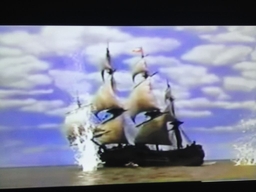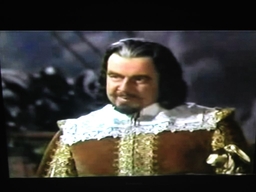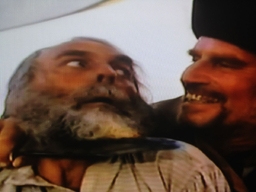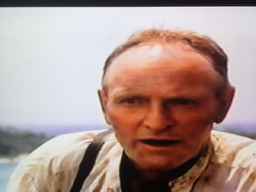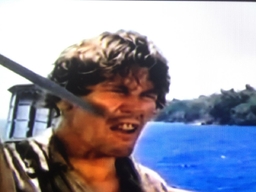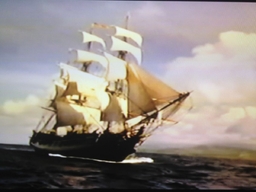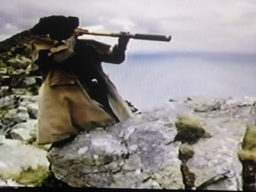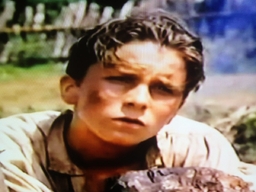-
Posts
652 -
Joined
-
Last visited
Content Type
Profiles
Forums
Events
Gallery
Everything posted by Daniel
-
Royal Navy rations provided the seamen a pound of pork on Sundays and another pound on Thursdays, per the 1707 Sea-Man's Vade Mecum. So I would expect salt pork would be available anywhere that the RN victualled.
-
Very best wishes to you and many happy returns!
-
I wonder if "the figure of a dead man" means a skeleton. If it was just a dead man with flesh still on him, how could you tell at a glace that he was dead?
-
Sory I've been away so long. I just finished taking the bar exam yesterday, and I was studying for it for about two months. I didn't dare come over here and do anything interesting for fear of getting distracted. If I can find what I did with that darn DVD of The Princess and the Pirate, I will post another pirate movie review.
-
Bartholomew Roberts' article VIII provides for pirates to duel, but only on shore. These rules are quite a bit less bloodlthirsty than the later "Irish"1 code duello of 1777. The requirement that both the pirates fire immediately is presumably meant to keep them from aiming carefully. The Irish code, on the other hand, says that the parties may fire "at their leisure," so they could aim, so long as they didn't rest their pistols on anything. The Irish code also forbade "second presents," which I think means that if you raised your pistol and then lowered it without shooting, you couldn't raise it again. The pirates' code provides for only one shot each, and then using swords. The Irish code contemplated two or even three shots per man; usually, the only way to end the duel after just one shot was if somebody apologized. When he dueled with Aaron Burr, Alexander Hamilton was expecting to have to shoot at least twice, although as it happened he was mortally wounded after the first shot. The pirates' code duello apparently always ends the duel at first blood, certainly with the swords, and presumably with the pistols also. Since the pirate duelers only draw cutlasses "if both miss," presumably any hit by either side ends the duel. From my own experience in saber fencing, I can say that first wounds from a fight with slashing weapons will very often be on the hand or arm. In contrast, the Irish code almost always requires "a severe hit" to conclude the duel, although any wound "sufficient to agitate the nerves and necessarily make the hand shake" stops the duel, all it does is "end the business for that day," so the duel is apparently expected to continue on a later day. But this is mostly speculation, because I have never heard of Roberts' Article VIII ever actually being used. And on at least two occasions the rule against striking another on board was violated by Roberts himself: aboard ship, he killed one crewman who insulted him, and stabbed another who objected. The guy he stabbed didn't use the dueling procedure either; he just threw Roberts over a cannon and beat the tar out of him. Roberts did threaten to duel some of his crewmen on occasion, but nobody ever took him up on it. The only real pirate duel I have ever heard of was between the buccaneers Laurens de Graaf and Nichola van Hoorn in 1683. This was a land duel, near Vera Cruz, Mexico, over a dispute about division of treasure. De Graaf cut van Hoorn's hand or arm, which became gangrenous and killed van Hoorn. Does anyone know of any other case of a real pirate duel? 1I'm putting "Irish" in quotation marks because the lords who put the code together were probably Anglo-Irish and Scots-Irish absentee landlords, who would likely have bristled at being called Irishmen.
-
Ah, the Golden Age; you may drown, but at least you'll die warm. I can easily imagine why the nose stimulation was thought to work. A happily recovering, but unconscious, guy has some extremely sharp odors brought under his nose and is shocked awake, and everybody assumes that the odor brought him back to life. Thanks, Mission!
-
One thing I've never figured out: during GAOP did people still dry the ink after writing by sanding the letter? Or did they use blotting paper already?
-
There are a ton of sources that say otherwise. "From the 1500s, Spain established colonies in Venezuela. As a result, the Spanish dollar was used as its currency for about 300 years." Lori McManus, Money Through History, p. 33. "[T]he Spanish dollar, which had been known on the Chinese coast since the early 16th century, functioned as the most important means of payment and clearing unit." Markus A. Denzel, Handbook of World Exchange Rates, 1590-1914, p. 507. "But this foreign dollar, this Spanish dollar of 1707, has undergone changes in value as the decades passed by." Parliamentary Papers, HOuse of Commons and Command, vol. 15, p. 80. As I understand it, the famous piece of eight was simply another name for the silver Spanish dollar. "The most widely used coin [in the American colonies] was the eight reales, piece of eight or Spanish dollar (peso)." Alvin Rabushka, Taxation in Colonial America, p. 154.
-

I Need help with me pirate facts
Daniel replied to Jake the SeaSnake's topic in Skull & Quill Society
Take what I say about this with a grain of salt; I've never found really strong evidence about how calms were dealt with, in the doldrums or elsewhere. 1. The doldrums are mostly calm, but not all the time; fitful and unpredictable winds would sometimes come along. The doldrums are narrower near South America, which is the best place to cross them. Lookouts could try to spot the "catspaw" pattern of wind on the water, and call to the helmsman to steer in that direction. I think that distant clouds were thought to be signs of wind too, but I'm not sure they were, nor am I sure whether clouds actually herald wind or not. And, of course, if you spied another ship a few miles away with her sails full and drawing, you knew that there was wind that way. 2. Yes, ships might be rowed with longboats, or the ship itself might have oars; Captain Kidd's Adventure Galley and Captain England's Fancy both had sweeps and oarports. Since rowing would wear the crew out in a hurry, I think it was done only for short distances to try to get the ship into a wind. I've never heard of anyone trying to row all the way across of the doldrums; the crew probably couldn't endure that. 3. And, sometimes, you just waited for the wind to come to you instead of trying to go to the wind, sitting "idle as a painted ship / Upon a painted ocean" until the wind picked up. A sailor's superstition was that whistling could bring a wind, and some captains tried to "whistle up a wind." I read long ago about a rather ghastly superstition that strangling the ship's cat would bring on a wind, but I've never seen the story repeated, and it may (we may hope) be untrue. -

I Need help with me pirate facts
Daniel replied to Jake the SeaSnake's topic in Skull & Quill Society
Sorry, I missed this before. I don't know if the Juncal's time included any stops, but certainly a lot of ships en route to Africa stopped at Cape Verde, and ships on a very long voyage like this might conceivably stop more than once. Captains believed that letting the men ashore helped prevent scurvy (not realizing that it was the availability of fresh vegetables ashore that was doing it). And any time you cross the equatorial doldrums between 10 degrees North and 10 degrees South, there's a good chance you'll spend many days becalmed. -

I Need help with me pirate facts
Daniel replied to Jake the SeaSnake's topic in Skull & Quill Society
Slavevoyages.org is a treasure trove of data on sailing in the era of the abominable slave trade. I find no record of any slave voyage from South Carolina to Madagascar, but there are several from South Carolina to Mozambique or Zanzibar, which would be a very similar voyage. The best documented voyage I see is Nuestra Senora del Juncal a Harmony's trip. She was a "bergantim," which I believe is a brigantine. She left Charleston Dec. 5, 1801, and began trade in Mozambique April 22, 1802, a passage of 138 days, or about three and a half months. Going to Ranter Bay or St. Mary's in Madagascar would have taken maybe a week longer than that. As for a site to lay in a course and see the number of nautical miles, the line and path functions on Google Earth are great for that. You can download it for free. -

What was the deepest water you could practically anchor in?
Daniel replied to Daniel's topic in Captain Twill
Thanks! I found a book on line by Jan Glete called Swedish Naval Administration, p. 455, which says that large Swedish warships generally had anchor cables 100 to 140 fathoms long, with smaller warships having proportionately shorter cables. This matches well with an example from the Ship Model Laboratory, which mentions a 120-fathom cable on Nelson's Victory. So it sounds like a typical large warship would have difficulty anchoring in more than about 40 fathoms of water, or maybe up to 47 for an exceptionally long cable. There's another ship-modeling post that says that, until the 19th century, most anchors had straight arms, not the gentle curve we're familiar with today! -
So, how deep could the water be and the ship still be able to anchor? And what's the limiting factor? I think having a 100-fathom anchor cable doesn't let you anchor in 100 fathoms of water. I think that for the anchor to bite properly, the anchor cable needs to be at an acute angle to the sea floor, and pictures I've seen of ships at anchor show the ship several hundred yards away from being directly above their anchors. You would only go directly above your anchor when you were preparing to haul it up. But is the length of your anchor cable the limiting factor? Beyond some length, does the combined weight of the anchor and cable become too much for the crew to lift up, or for the capstan to withstand?
-
While the ship is wearing (i.e. the stern of the ship is passing through the wind's eye as it turns), the boom of the spanker or other fore-and-aft sail may sweep across the deck, which can knock you overboard or break your neck if you're not looking out for it. Also, the blocks/pulleys are always moving about in unpredictable directions aloft. Once, while I was on the foremast head of the St. Lawrence II, the crew on deck started lifting something with a block and tackle, and the block caught my shirt and started to lift me. They stopped and I was able to disentangle myself, but less alertness on their part could have thrown me off the mast head. While it is very unlikely that the captain or other senior officer would be aloft himself to save the hapless, his timely shouted warning could prevent such an accident.
-

How did you careen ships in the tideless Caribbean?
Daniel replied to Daniel's topic in Captain Twill
Great pictures! I see that there was some sort of raft or platform used to avoid having to stand in the water while working on the bottom. But I didn't realize that it was not necessary to get the ship entirely out of the water before careening. Thank you very much! -
Careening: the act of beaching one's ship, turning it over on its side, cleaning the bottom and adding/replacing hull planks. WIthout careening, teredoes and barnacles and seaweed will first slow and then destroy the ship. Now, even a small vessel will have a draught of five feet or more; the brigantine St. Lawrence II, for example, has an 8.5 foot draught. So as you sail your ship toward the beach, you will run aground in five to eight feet of water. Obviously,it will be difficult or impossible to work on the bottom while standing in the middle of crashing surf. In ordinary seas, the solution is presumably to ground the ship at high tide; when the tide goes out, your ship is left high and dry and ready to work on. But the Caribbean Sea has no appreciable tides. How do you careen there? We know that pirates did careen in the Caribbean; Captain Lowther was captured while careening on Blanquilla, off Venezuela. Did the pirates somehow drag fifty- or sixty-ton sloops out of the water and onto the dry beach, and then back again? And what did they do with big ships like the Queen Anne's Revenge or the Royal Fortune?
-
Rousted my son with pirate talk this morning, but didn't have much chance to talk like a pirate after that.
-
I love the part where he drinks the water off the leaf!
-
A simple question, I think: how, historically, did people draw the charge from a flintlock or other muzzle-loader if it misfired? If only the priming powder was wet or spoiled, re-priming would seem relatively easy, but if the actual main charge in the gun barrel proved to be wet or otherwise faulty, how did you get it and the ball and the wadding out? In the novel Treasure Island, Stevenson has Jim Hawkins draw the charge on one of his pistols and then reload it in the time it takes Israel Hands to climb to the Hispaniola's mizzen top. That sounds impossible; is it?
-
TREASURE ISLAND (1990) Featuring: Christian Bale, Charlton Heston, Oliver Reed, Julian Glover, Richard Johnson, Clive Wood, Christopher Lee, Michael Halsey, Pete Postlethwaite, Nicholas Amer, Isla Blair, John Benfield, John Abbott, James Cosmo. Daniel’s rating: 4½ out of 5. Synopsis: Billy Bones is an unwelcome lodger at Jim Hawkins’s Admiral Benbow Inn; Bones’s ex-comrades, pirates all, are even less welcome when they come looking for his treasure map. Young Jim escapes with the map, and together with his grown-up patrons Squire Trelawney and Dr. Livesey, they sail in search of the treasure. And with them sails Long John Silver, the warm and fatherly one-legged sea cook who just happens to be the smartest and most ruthless of the pirates who buried the treasure in the first place. But Jim accidentally learns that Silver plans to lead a mutiny, take the treasure, and kill Livesey, Trelawney, the captain, and perhaps Jim too. Evaluation: I’ve seen eight versions of Treasure Island in my life, and this one by Charlton Heston’s son, Fraser Clarke Heston, is the best. Not because it’s the truest to the original novel – although it is – but because it has the clearest vision and purpose. Both when Heston is telling Stevenson’s story and when he is telling his own, he takes the tale seriously, and lavishes love on it. Let’s start with the elder Heston. No production of Treasure Island can be better than its Long John Silver, and Charlton Heston is one of the best ever to play the role. His performance here is dialed back several notches from Robert Newton’s full-broadside dynamism; this Silver is quieter and more restrained, but has every bit of the cunning and subtlety of Stevenson’s original, all covering up a satanic savagery at his core that he lets loose when it serves him best. But he has another side, a paternal side that admires Jim Hawkins’s wit and pluck, which is so much like his own and so unlike his stupid and weak shipmates’. He clearly means it when he tells his pirates, “I like that boy. I’ve never seen a better boy than that. He’s more a man than any pair of you bilge rats aboard of here!” The other half of the story is Christian Bale's Jim Hawkins, struggling to live up to the example of his heroes: Livesey, Trelawney, and Captain Smollett. This is why we are supposed to root for Jim's allies to find the treasure first, even though they have no more lawful claim to it than Silver’s pirates do: because they are morally superior to the pirates by dint of their honesty, piety, courage, loyalty, temperance, and industry. These values sound stuffily middle class to us today, but they were the steel and concrete that built Stevenson’s world. Jim aspires to these virtues, and by the end of the movie he has won them. Jim stands by his word to Long John Silver to testify in his favor in court, but when Silver gruesomely describes his own imminent hanging in an effort to get Jim to go beyond his word and let SIlver loose, Jim won’t bite the hook. His acid reply, “Maybe you should have thought of that before you turned to piracy,” seems to be aimed not only at Silver, but at the sappy ending of the 1934 Wallace Beery version. Behind the leads is a standout supporting crew, led by Julian Glover’s Dr. Livesey, who slowly realizes that his deference to Trelawney is misplaced, and grows into the leader of the expedition. Then there is Oliver Reed, surely the best Billy Bones ever. The movie retreats a little from its moralistic stance to show what a tragic character Bones is; he beat the odds for twenty years, evading scurvy, the noose, cannon fire, malaria,yellow fever, storms, and shoals, to finally reached the pirate’s dream of retiring with his plunder. And having achieved everything he ever wanted, he literally cannot think of anything to do but to drink himself to death. The pathos is still greater when you consider that Reed himself had a serious drinking problem that finally killed him. As I said, this is a very faithful adaptation, probably the closest ever made to Stevenson’s original. But the movie’s real virtue is not slavish copying for its own sake, but simply recognizing what was best in Stevenson’s original and using it to best advantage. When Fraser Heston departs from Stevenson’s text, it is almost always to make an improvement. Stevenson makes Jim’s mother faint, even though she is a hardy and determined woman; in the movie, she defends her inn at gunpoint, making her a far more memorable and consistent character. Stevenson makes Israel Hands a coxswain, which never plays any role in the plot; in the film he is a gunner, which proves very important. Stevenson’s Silver makes an uncharacteristic tactical error by assaulting the stockade without any support or plan; here, he has a cannon dragged up to soften up the stockade, which incidentally lets him fight in the battle personally, and which very nearly defeats the good guys. But one deviation from the book is less justifiable: it makes no sense for Billy Bones to admit his real name as soon as he walks in the door of the Admiral Benbow, since his whole reason for staying there is to avoid being recognized. The film was shot on location in Jamaica and England, and has magnificent scenery, brought even more to life by the Chieftains’ stirring musical score. Long stretches of Stevenson’s beautifully salty dialogue are adopted intact, making you feel that you are really in the 18th century. And the battle scenes, apparently done without a fight choreographer, are outstanding, full of real desperation; at the end of the stockade battle, all the heroes are nearing exhaustion and gasping for water. Not many directors are willing to suppress their vanity and tell another man’s story as best they know how. Fraser Clarke Heston was one of the rare exceptions. And that’s why this film is not only the best Treasure Island ever made, but a serious candidate for the best pirate movie of all. Piratical tropes and comments: Like any version of Treasure Island, this one is heavy on famous tropes. Silver’s parrot Captain Flint is present, played by a red-lored Amazon that fits comfortably on the shoulder; she’s green, just like in the novel. Of course, there is also a one-legged pirate, although the movie follows the novel in giving Silver a crutch rather than a peg leg. And as always, there is the treasure map with X marking the spot – multiple X’s, in fact, since Captain Flint decided not to put all his eggs in one basket. “I’m cap’n here, by ‘lection,” says Silver, quoting the book and accurately showing how pirate captains were chosen. Although we never see the articles of Flint’s crew, it is clear that they have them and that they lay great store by them; Silver himself is not ready to break the “rules” until pushed to the last extremity. But it is clear that these rules are a way the pirates have of getting along in company; they are not moral principles, and the pirates discard them quickly whenever they are left alone, or even in pairs, as Billy Bones and Israel Hands show. The knife in the teeth is present here, and makes some sense in context. Israel Hands is trying to stab Jim Hawkins; when Jim climbs the rigging, Hands just clamps the blade in his teeth and climbs after him, rather than lose time by tucking the blade back into the secret scabbard inside his shirt where he had it hidden. As usual, the Hispaniola is portrayed by a full-rigged ship: the same Bounty that appeared in the Marlon Brando Mutiny on the Bounty and the Pirates of the Caribbean movies, and which was tragically lost in Hurricane Sandy along with her captain and a deck hand. It is the only pirate ship I’ve seen that has a pump, which Jim Hawkins improbably uses as a weapon. The ship is equipped with a spritsail and spritsail topsail, which would have been some of the last of their kind in the 1750s, but it does have a wheel, which by that time had been widely adopted. The sails are recognizably 19th century – short-leeched, taut, and tapering toward the top – instead of the long-leeched, billowing sails of the early-to-mid- 18th century. But the Bounty was a beauty and Fraser Heston knew it, giving the ship a full share of the spotlight. This is the only pirate movie I’ve ever seen which uses the word “avast” correctly, as a command to stop what one is doing, as in Smollett’s crisp order “avast talking.” Other nautical language is sprinkled liberally throughout, and used very accurately: “to raise an island” meaning to come within sight of it, “a lee shore” for a dangerous situation, and “ran down our easting” for making eastward progress. But Silver’s use of “bucko” as a term of endearment is a late 19th century anachronism. The usual cocked hats, broad belts, and puffy-sleeved linen shirts are on display, but no bucket boots. Trelawney and Livesey have short white wigs that look like something George Washington would wear. Several of the sailors wear peaked hats that could almost pass for Monmouth caps, except that they bend backward instead of forward. The Jolly Roger here appears in its most popular form: white full-face skull above crossed bones on black field. The movie faithfully copies Stevenson’s rather absurd use of the flag, even including Ben Gunn’s silly observation that “Silver would fly the Jolly Roger” above the stockade if he had captured it! Kudos, though, for showing a merchant ship flying a Red Ensign rather than the full Union Jack. Weaponry is ordinary flintlocks and basket-hilted cutlasses, which look fairly authentic except for being a bit on the long side. Jim is put through the harrowing ordeal of having to re-prime his pistols while Israel Hands climbs up the rigging to murder him. We get to see a blunderbuss, rarely shown in the movies, but it is used by Jim’s mother, not by the pirates. Its kick is enough to knock her down! In all, there’s plenty of piratey goodness to go around. Certainly, there’s more than enough for a story which (we too easily forget) takes place a good twenty or thirty years after the end of the Golden Age of Piracy. Charlton Heston's Long John Silver. God, how I love being evil! Christian Bale's Jim Hawkins really needs a Bat-Signal about now. Oliver Reed's Billy Bones, looking for trouble - and finding it. Julian Glover's Dr. Livesey is impressed by Jim Hawkins. Michael Halsey's mild, inoffensive Israel Hands. Introducing the Bounty in the role of the Hispaniola. Israel Hands brings a knife to a gunfight. Ben Gunn has to stop meeting Long John Silver like this.
- 34 replies
-
- movies
- pirate art
-
(and 3 more)
Tagged with:
-


